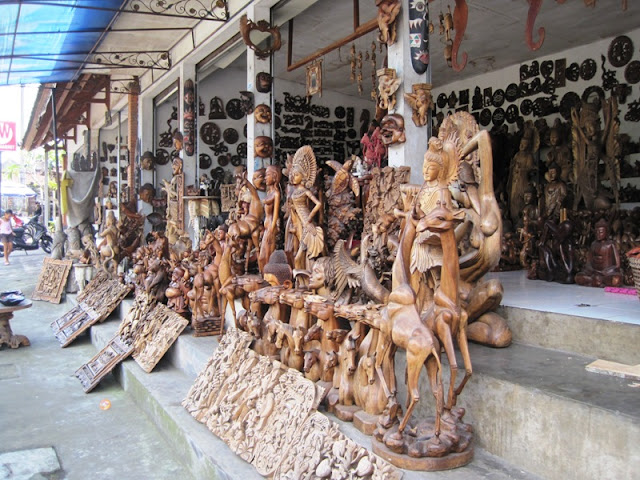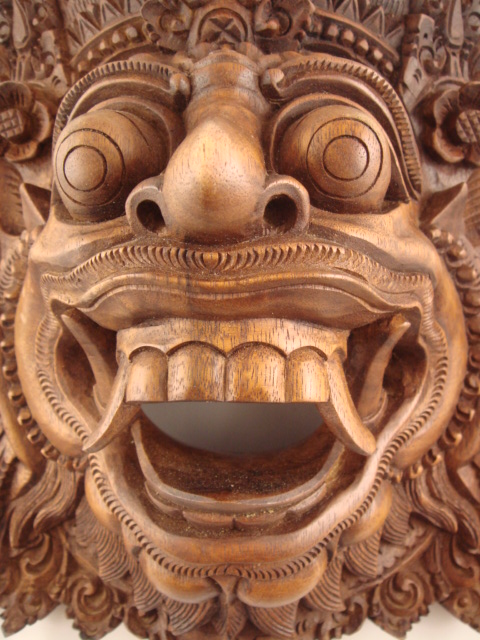Arts and Crafts
The Balinese are surrounded by art throughout their lives as art is omnipresent in Bali. They make art out of the most basic necessities in their daily lives. However, artistic knowledge is not commissioned only to a special intellectual class, but is open to everyone at all levels. Painting, sculpture, carving and music have traditionally been the province of men, while women channeled their creative energy into creating lavish offerings to the gods. In every festival, you can see spectacular pyramids of flowers, fruit, and cakes up to two meters high, constructed with such love and adoration that it could only be meant for a higher being. Although a religiously regarded practice, Balinese art does not serve religion solely. Bemos, jackets, menus, motorcycles, hotel doorways and other objects are decorated with sacred symbols. They do not view this use as sacrilegious. It is incredible to see so many people in such a small area pour so much energy into creating beautiful things. Traveller who came to Bali also can follow art workshop and create their own artwork. This is a very interesting activity for tourist when they coming to Ubud.
Painting
 |
| Keliki Painting Style By Ngurah Jamu |
 |
| By I Wayan Suardana Kojex |
 |
| Painting by I Gusti Ngurah Prawira |
Balinese painting is classified into certain groups and styles, not without some overlaps and a few that do not fit into any of the main styles. First is the Kamasan or classical painting, which is also named the wayang style. This style can be traced back to ninth century Javanese sculpture that features wayang figures, rich floral designs, and flame-and-mountain motifs characteristic of classical Balinese painting. There is also the Pita Maha, which literally means 'great vitality'. This group was formed when painting was dying out as an art form and in a serious decline due to styles becoming stagnant. Walter Spies and Rudolf Bonnet were western artists who, along with their patron Cokorda Gede Agung Sukawati, formed the Pita Maha to encourage painting as an art form and seek a market for the best paintings. Other styles include theYoung Artists and variants of the main Kamasan and Young Artists'styles.
Wood Carving
The Balinese sculpture with natural media - wood, stone, bone, horn, deadwood, and even gnarled tree roots. Nowadays, souvenir-caliber wood carving is churned out and successful creations are mass produced. Any visitor to Bali is likely to be exposed to wood carving in all forms, be it the traditional ornate carved doors, the carved figures of gods, or the countless carved items in craft shops.
Wood carving is a craft practiced all over Bali. Open your ears to the tapping sound of the carver's mallet and you would know that there is one around. It would be taxing to separate traditional and foreign influences. However, Balinese are intense observers of the outside world, effortlessly incorporating and adapting foreign themes into their work.
For quality wood carving, head to Tegallalang, Pujung, and Sebatu, which is north of Ubud. It is a great area to meet woodcarvers; it is best to take note of the artist's name and visit him at the workshop to negotiate a better price.
Bali is a perfect place for western artists to study their crafts. There are wood carving lessons in which you can learn to carve your own mask in about three weeks.
Mask Carving
This is a specialized form of wood carving that should only be executed by experts. An extremely high level of skill is required to produce the 30 or 40 masks used in dances. Masks of Barong and Rangda are opulently painted and assembled with real hair, enormous teeth, and bulging eyes. The mask carving center of Bali is Mas and Puaya.
Stone Carving
The technique used in stone carving is very much the same as wood carving since soft volcanic rock is used. Stone carving is relatively unaffected by tourist consumerism as most pieces are too exorbitant to ship. You can vividly see stone carving skills in the distinctive split gates, swirling stone friezes, and absurd and menacing mythological statuary. The centers for stone carving are Kapal and Batubulan.
Jewelry
Bali is also famous for its jewelry, along with Thailand and Mexico, and variations on the same designs are common to all three countries. Balinese jewelry is almost always handmade, thus rarely involving casting techniques or the usage of imported silver. Silver is mined in Bali near Singaraja and used for filigree and other traditional silver work. Members of the royal family adorn themselves with gold and silver headdresses, belts, bracelets, earrings, anklets and necklaces to indicate their high status. Even handles of krises or daggers and umbrella finials would be made of gold. The village of Celuk is known for its rings, bracelets, necklaces, pins, and other objects of silver. Kamasan remains the center for traditional gold and silver jewelry.
Balinese are quick to pick up designs introduced by outsiders and will copy things that will sell well. Many imaginative smiths are starting to duplicate designs from magazines or international jewelry designers who have settled in Bali to work.
Textiles
The first kind of textile that you will find in Bali is batik, which is popular among tourists and locals alike. There is every imaginable style and quality that you can chance upon throughout the island, but it is surprising that batik is actually produced in central Java and then shipped to Bali. Bali's own home-produced cloth is a weft ikat called endek. Ikat is made by tying the weft threads of a cloth before it is woven and then dying them so that the tied areas do not absorb the dye. The cloth is then woven and the pattern, created by the tying of the threads, emerges. This cloth is not very popular with visitors but is indispensable to the locals. Authentic ikat is made of silk but cotton and synthetic yarns are also widely used. Also, keep a look out for kain prada, fabrics woven of silk or cotton and decorated with silver or gold threads or gold leaf. These colorful kerchiefs are worn by temple girls during festivals and take three weeks to a month to weave.























No comments:
Post a Comment